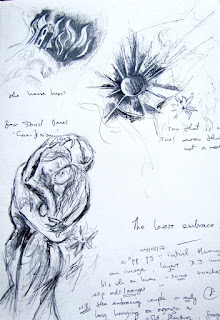I chose Crucifixion 1927 by David Jones because of the multiple imagery that accorded with the layering of my stitched pieces, his spirituality and also the affinity I felt between the marks of his wood engraving and my own hand stitch. I gave my section the title Reconciliation Path.
This view shows the wall in the gallery that was dedicated to most of my work on exhibition - one further piece Futility was shown on the opposite wall.
This is the print Crucifixion by David Jones. It is a wood engraving on white Japanese paper made for Llyfr y Pregeth-wr; the Book of Ecclesiastes published by the Gregynog Press.
The Book is seen here in its box in the display cabinet, Gallery 1, the School of Art.
The image here is of the whole cabinet and shows the book beside the artefacts chosen by Carmen Mills for her work - they made a nice display together.
When I started looking at the print, I began my ideas for work by sketching from the print:-
Initial sketch from the print.
I then began thinking along the lines of a piece in multiple imagery, as David Jones had done with his print and I have often done with my textile pieces and installations, so I began with a pen and ink sketch comprising images from my own drawings:-
My initial intention had been to make a two-sided hanging in multiple imagery but, as the piece grew and visual ideas developed, it became clear that the issues depicted would be better served by being viewed as two separate hangings, so Conflict's Web and Reconciliation were born.
Gunmen and poppies from Conflict's Web.
A central image for the theme of the piece, the armed gunmen are connected to one another and to poppy images by the stitches of the 'web'. The impetus for these figures was a mural of gunmen I had seen in East Belfast, making them originate from a Loyalist organisation. However, I altered the image to make it ambiguous as to which 'side' they might belong to; gunmen maimed, killed and terrorised from both sides of the conflict.
David Jones drew images of the Passion Flower in his work, drawing full blooms on each side of the embracing couple and a figure at the foot of cross holds high a bunch of the flowers in his hand. This flower is symbolic of Christianity through various parts of the flower relating to Christ and His passion or crucifixion. Within this symbolism, the leaves of the plant are said to represent the holy lance or spear that pierced Christ's side and David Jones has featured many of these leaves in the ground of his print.
The print by David Jones was destined for a book of
the bible, so it was natural that he should employ a passion flower, symbol of
Christianity. My work, however, was not destined for such a purpose and I
decided to use the image of the poppy in all that it symbolises. The poppy has
been used so very many times already but despite the universality of its use, I
think it can still speak to us through the many different ways in which it has
appeared in artworks, through the flower's character of tenacity through
fragility and also in its most common variety, through the petals brightly red
as blood.
I had made pencil drawings of poppies growing in
our garden and used these images for the poppies on the hangings that I was
making for the exhibition.
Poppies on the hanging Reconciliation . . .
. . . and as they appeared around the figure in the kitchen, one of the images on the hanging. The original here was a pencil drawing I had made in 1971 of my grandmother in the kitchen which I made into an etching. On the hanging, the etching is reproduced as a digital print on linen, then further stitched into by hand.
Futility on exhibition in Gallery 1 in
the In a New Light Exhibition.
This doorway image is from my piece Aftermath
This photo of myself by my work in the exhibition
shows my piece Destruction's Path on my right and behind me, the
main piece Aftermath with small pieces that formed the complete
work for the exhibition.
This photo of myself talking with visitors was
taken at the Opening of the Exhibition.
We had a very good experience exhibiting together
in the School of Art and there were some lovely comments written in the
Visitors' Book about the exhibition in general with some really nice comments about my own work. I also owe thanks to those who contacted me personally to
say how my work had touched them.














































